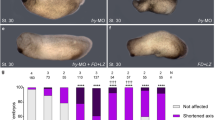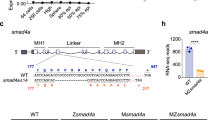Abstract
Dishevelled (Dsh) is required for the specification of cell fate and polarity by secreted Wnt proteins. Frodo, a novel conserved Dsh-binding protein, synergized with Xenopus Dsh (XDsh) in secondary axis induction in Xenopus laevis embryos. A dominant inhibitory construct and antisense oligonucleotide-mediated depletion of Frodo inhibited axial development in response to XDsh and XWnt8, and suppressed transcriptional activation of a reporter construct. At later embryonic stages, both dominant negative Frodo and antisense oligonucleotides interfered with the expression of regional neural markers and caused eye deficiencies, indicating that Frodo is required for normal eye and neural tissue development. Full-length Frodo RNA suppressed these loss-of-function phenotypes, attesting to their specificity. These findings establish a function for Frodo as an essential positive regulator of Wnt signalling.
This is a preview of subscription content, access via your institution
Access options
Subscribe to this journal
Receive 12 print issues and online access
$209.00 per year
only $17.42 per issue
Buy this article
- Purchase on Springer Link
- Instant access to full article PDF
Prices may be subject to local taxes which are calculated during checkout








Similar content being viewed by others
References
Nusse, R. & Varmus, H. E. Wnt genes. Cell 69, 1073–1087 (1992).
Gumbiner, B. M. Propagation and localization of Wnt signaling. Curr. Opin. Genet. Dev. 8, 430–435 (1998).
Peifer, M. & Polakis, P. Wnt signaling in oncogenesis and embryogenesis – a look outside the nucleus. Science 287, 1606–1609 (2000).
Sokol, S. Y. Wnt signaling and dorso-ventral axis specification in vertebrates. Curr. Opin. Genet. Dev. 9, 405–410 (1999).
Yanagawa, S. et al. The dishevelled protein is modified by wingless signaling in Drosophila. Genes Dev. 9, 1087–1097 (1995).
Sokol, S. Y. Analysis of Dishevelled signalling pathways during Xenopus development. Curr. Biol. 6, 1456–1467 (1996).
Boutros, M. & Mlodzik, M. Dishevelled: at the crossroads of divergent intracellular signaling pathways. Mech. Dev. 83, 27–37 (1999).
Axelrod, J. D., Miller, J. R., Shulman, J. M., Moon, R. T. & Perrimon, N. Differential recruitment of Dishevelled provides signaling specificity in the planar cell polarity and Wingless signaling pathways. Genes Dev. 12, 2610–2622 (1998).
Boutros, M., Paricio, N., Strutt, D. I. & Mlodzik, M. Dishevelled activates JNK and discriminates between JNK pathways in planar polarity and wingless signaling. Cell 94, 109–118 (1998).
Shulman, J. M., Perrimon, N. & Axelrod, J. D. Frizzled signaling and the developmental control of cell polarity. Trends Genet. 14, 452–458 (1998).
Strutt, D. I., Weber, U. & Mlodzik, M. The role of RhoA in tissue polarity and Frizzled signalling. Nature 387, 292–295 (1997).
Moriguchi, T. et al. Distinct domains of mouse dishevelled are responsible for the c-Jun N-terminal kinase/stress-activated protein kinase activation and the axis formation in vertebrates. J. Biol. Chem. 274, 30957–30962 (1999).
Wallingford, J. B. et al. Dishevelled controls cell polarity during Xenopus gastrulation. Nature 405, 81–85 (2000).
Tada, M. & Smith, J. C. XWnt11 is a target of Xenopus Brachyury: regulation of gastrulation movements via Dishevelled, but not through the canonical Wnt pathway. Development 127, 2227–2238 (2000).
Ponting, C. P., Phillips, C., Davies, K. E. & Blake, D. J. PDZ domains: targeting signalling molecules to sub-membranous sites. Bioessays 19, 469–479 (1997).
Zeng, L. et al. The mouse Fused locus encodes Axin, an inhibitor of the Wnt signaling pathway that regulates embryonic axis formation. Cell 90, 181–192 (1997).
Ponting, C. P. & Bork, P. Pleckstrin's repeat performance: a novel domain in G-protein signaling? Trends Biochem. Sci. 21, 245–246 (1996).
Li, L. et al. Axin and Frat1 interact with Dvl and GSK, bridging Dvl to GSK in Wnt-mediated regulation of LEF-1. EMBO J. 8, 4233–4240 (1999).
Smalley, M. J. et al. Interaction of axin and Dvl-2 proteins regulates Dvl-2-stimulated TCF-dependent transcription. EMBO J. 18, 2823–2835 (1999).
Itoh, K., Antipova, A., Ratcliffe, M. J. & Sokol, S. Interaction of dishevelled and Xenopus axin-related protein is required for wnt signal transduction. Mol. Cell. Biol. 20, 2228–2238 (2000).
Yan, D. et al. Cell autonomous regulation of multiple Dishevelled-dependent pathways by mammalian Nkd. Proc. Natl Acad. Sci. USA 98, 3802–3807 (2001).
Rousset, R. et al. Naked cuticle targets Dishevelled to antagonize Wnt signal transduction. Genes Dev. 15, 658–671 (2001).
Peters, J. M., McKay, R. M., McKay, J. P. & Graff, J. M. Casein kinase I transduces Wnt signals. Nature 401, 345–350 (1999).
Sakanaka, C., Leong, P., Xu, L., Harrison, S. D. & Williams, L. T. Casein kinase-ɛ in the Wnt pathway: regulation of β-catenin function. Proc. Natl Acad. Sci. USA 96, 12548–12552 (1999).
Willert, K., Brink, M., Wodarz, A., Varmus, H. & Nusse, R. Casein kinase 2 associates with and phosphorylates dishevelled. EMBO J. 16, 3089–3096 (1997).
Sun, T. Q. et al. PAR-1 is a Dishevelled-associated kinase and a positive regulator of Wnt signaling. Nature Cell Biol. 3, 628–636 (2001).
Park M., Moon R. T. The planar cell-polarity gene stbm regulates cell behaviour and cell fate in vertebrate embryos. Nature Cell Biol. 4, 20–25 (2002).
Habas R., Kato Y., He X. Wnt/Frizzled activation of Rho regulates vertebrate gastrulation and requires a novel Formin homology protein Daam1. Cell 107, 843–854 (2001).
Blake, D. J. et al. Coiled-coil regions in the carboxy-terminal domains of dystrophin and related proteins: potentials for protein-protein interactions. Trends Biochem. Sci. 20, 133–135 (1995).
Kornau, H. C., Schenker, L. T., Kennedy, M. B. & Seeburg, P. H. Domain interaction between NMDA receptor subunits and the postsynaptic density protein PSD-95. Science 269, 1737–1740 (1995).
Rothbacher, U. et al. Dishevelled phosphorylation, subcellular localization and multimerization regulate its role in early embryogenesis. EMBO J. 19, 1010–1022 (2000).
Guger, K. A. & Gumbiner, B. M. β-Catenin has Wnt-like activity and mimics the Nieuwkoop signaling center in Xenopus dorsal-ventral patterning. Dev. Biol. 172, 115–125 (1995).
Summerton, J. & Weller, D. Morpholino antisense oligomers: design, preparation, and properties. Antisense Nucleic Acid Drug Dev. 7, 187–195 (1997).
Itoh, K., Jacob, J. & Sokol, S. Y. A role for Xenopus Frizzled 8 in dorsal development. Mech. Dev. 74, 145–157 (1998).
Harland, R. & Gerhart, J. Formation and function of Spemann's organizer. Ann. Rev. Cell. Dev. Biol. 13, 611–667 (1997).
Mathers, P. H., Grinberg, A., Mahon, K. A., & Jamrich, M. The Rx homeobox gene is essential for vertebrate eye development. Nature 387, 603–607 (1997).
Rasmussen, J. T. et al. Regulation of eye development by frizzled signaling in Xenopus. Proc. Natl Acad. Sci. USA 98, 3861–3866 (2001).
Miller, J. R. et al. Establishment of the dorsal-ventral axis in Xenopus embryos coincides with the dorsal enrichment of dishevelled that is dependent on cortical rotation. J. Cell Biol. 146, 427–437 (1999).
Liu P. et al. Requirement for Wnt3 in vertebrate axis formation. Nature Genet. 22, 361–365 (1999).
Sumanas, S., Strege, P., Heasman, J. & Ekker, S. C. The putative Wnt receptor Xenopus frizzled-7 functions upstream of β-catenin in vertebrate dorsoventral mesoderm patterning. Development 127, 1981–1990 (2000).
Sokol, S. Y. A role for Wnts in morphogenesis and tissue polarity. Nature Cell Biol. 2, E124–E126 (2000).
Winklbauer R., Medina A., Swain R. K. & Steinbeisser H. Frizzled-7 signalling controls tissue separation during Xenopus gastrulation. Nature 413, 856–860 (2001).
Sambrook, J., Fritsch, E. F. & Maniatis, T. Molecular Cloning: A Laboratory Manual 2nd edn (Cold Spring Harbor Laboratory Press, Cold Spring Harbor, NY, 1989).
Holowacz, T. & Sokol, S. Y. FGF is required for posterior neural patterning but not for neural induction. Dev. Biol. 205, 296–308 (1999).
Krieg, P. A. & Melton, D. A. Functional messenger RNAs are produced by SP6 in vitro transcription of cloned cDNAs. Nucleic Acids Res. 12, 7057–7070 (1984).
Newport, J. & Kirschner, M. A major developmental transition in early Xenopus embryos: I. Characterization and timing of cellular changes at the midblastula stage. Cell 30, 675–686 (1982).
Nieuwkoop, P. D. & Faber, J. Normal Table of Xenopus laevis (Daudin). (North Holland Publ., Amsterdam, Holland, 1967).
Kao, K. R. & Elinson, R. P. The entire mesodermal mantle behaves as Spemann's organizer in dorsoanterior enhanced Xenopus laevis embryos. Dev. Biol. 127, 64–77 (1988).
Itoh, K., Krupnik, V. E. & Sokol, S. Y. Axis determination in Xenopus involves biochemical interactions of axin, glycogen synthase kinase 3 and β-catenin. Curr. Biol. 8, 591–594 (1998).
Sive, H. L., Grainger, R. M. & Harland, R. M. Early Development of Xenopus laevis, Course manual (Cold Spring Harbor Laboratory Press, Cold Spring Harbor, NY 1995).
Acknowledgements
We thank K. Itoh for the initial identification of Frodo fragments in the yeast two-hybrid screen. We are grateful to I. Dawid, J. Graff, B. Gumbiner, A. Hemmati-Brivanlou, R. Harland, M. Jamrich, P. Lemaire, R. Moon, E. De Robertis and J. Smith for plasmids, and T. Komiya for the Xenopus ovary cDNA λZAP library. We also thank J. Green, Y. Kamberov and M. Ratcliffe for comments on the manuscript. This work was supported by the grants from the March of Dimes Birth Defects Foundation and the National Institutes of Health to S.S. and the Deutsche Forschungsgemeinschaft to J.G.
Author information
Authors and Affiliations
Corresponding author
Ethics declarations
Competing interests
The authors declare no competing financial interests.
Rights and permissions
About this article
Cite this article
Gloy, J., Hikasa, H. & Sokol, S. Frodo interacts with Dishevelled to transduce Wnt signals. Nat Cell Biol 4, 351–357 (2002). https://doi.org/10.1038/ncb784
Received:
Revised:
Accepted:
Published:
Issue Date:
DOI: https://doi.org/10.1038/ncb784
This article is cited by
-
Condensing and constraining WNT by TGF-β
Nature Cell Biology (2021)
-
TGF-β-induced DACT1 biomolecular condensates repress Wnt signalling to promote bone metastasis
Nature Cell Biology (2021)
-
Leucine repeat adaptor protein 1 interacts with Dishevelled to regulate gastrulation cell movements in zebrafish
Nature Communications (2017)
-
Roles of two types of heparan sulfate clusters in Wnt distribution and signaling in Xenopus
Nature Communications (2017)
-
DACT1 is involved in human placenta development by promoting Wnt signaling
Archives of Gynecology and Obstetrics (2015)



